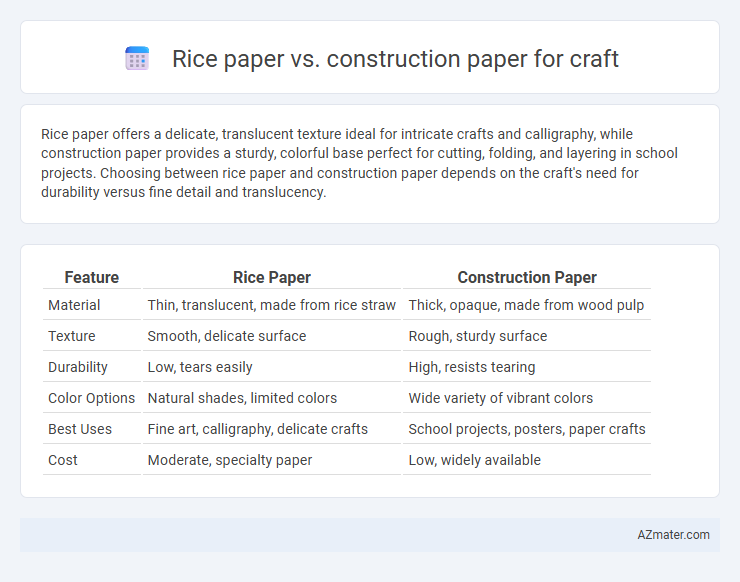Rice paper offers a delicate, translucent texture ideal for intricate crafts and calligraphy, while construction paper provides a sturdy, colorful base perfect for cutting, folding, and layering in school projects. Choosing between rice paper and construction paper depends on the craft's need for durability versus fine detail and translucency.
Table of Comparison
| Feature | Rice Paper | Construction Paper |
|---|---|---|
| Material | Thin, translucent, made from rice straw | Thick, opaque, made from wood pulp |
| Texture | Smooth, delicate surface | Rough, sturdy surface |
| Durability | Low, tears easily | High, resists tearing |
| Color Options | Natural shades, limited colors | Wide variety of vibrant colors |
| Best Uses | Fine art, calligraphy, delicate crafts | School projects, posters, paper crafts |
| Cost | Moderate, specialty paper | Low, widely available |
Introduction to Rice Paper and Construction Paper
Rice paper, traditionally made from the pith of the rice plant or other plant fibers, offers a translucent, lightweight texture ideal for detailed art projects, calligraphy, and delicate paper crafts. Construction paper, composed of recycled paper pulp with a rough texture and vibrant colors, serves as a sturdy material favored for children's crafts, collages, and classroom projects. Both materials vary in durability and finish, influencing their suitability for specific craft applications and artistic techniques.
Key Material Differences
Rice paper is made from natural fibers like mulberry, giving it a thin, translucent quality ideal for delicate art and calligraphy, whereas construction paper is manufactured from wood pulp, resulting in a thicker, more opaque material suited for sturdy craft projects. The texture of rice paper is smooth and slightly absorbent, enhancing ink and paint blending, while construction paper has a rougher surface that holds glue and markers effectively. Moisture sensitivity is high in rice paper, making it prone to tearing when wet, unlike construction paper, which is more durable and resistant to water damage during crafting.
Texture and Appearance Comparison
Rice paper features a smooth, translucent texture ideal for delicate craft projects requiring subtle layering and light diffusion, while construction paper offers a coarse, opaque surface suited for bold, vibrant creations. The fine fiber composition of rice paper imparts a soft, almost silky appearance, contrasting with the dense, matte finish of construction paper that enhances color richness and durability. Texture-wise, rice paper is fragile and flexible, perfect for intricate detailing, whereas construction paper is sturdy and rigid, supporting structural designs in crafting.
Durability and Strength
Rice paper is delicate and lightweight, making it prone to tearing and less durable for heavy-duty craft projects, whereas construction paper offers greater strength and resilience due to its thicker, sturdier fibers. Construction paper withstands folding, cutting, and gluing better, supporting more complex and long-lasting craft designs. For projects requiring durability and structural integrity, construction paper is the preferred choice over fragile rice paper.
Versatility in Craft Projects
Rice paper offers superior versatility in craft projects due to its translucent, lightweight texture that allows layering, folding, and delicate detailing, ideal for origami, collage, and decoupage. Construction paper, while sturdier and available in vibrant colors, is less flexible and more prone to tearing during intricate manipulations but excels in basic cut-and-paste crafts and children's projects. The choice between rice paper and construction paper depends on the project's complexity, desired texture, and durability requirements.
Ease of Cutting and Shaping
Rice paper is much thinner and more delicate than construction paper, making it easier to cut intricate shapes with precision and minimal resistance. Its smooth texture allows for clean edges when using fine tools like craft knives or scissors, ideal for detailed projects such as origami or paper flowers. Construction paper's thicker, coarser fibers provide sturdiness but require more effort to cut and shape, often resulting in rougher edges and less flexibility for detailed work.
Compatibility with Art Media (Paint, Ink, Glue)
Rice paper exhibits exceptional compatibility with water-based paints, inks, and adhesives due to its absorbent texture, allowing vibrant colors and smooth ink flow without bleeding. Construction paper, while sturdier and more resilient, tends to warp or buckle under heavy application of water-based media but holds well with dry mediums and glue. The porous nature of rice paper enhances blending and layering techniques, whereas construction paper's coarse surface may hinder fine detail work in painting and ink drawings.
Environmental Impact and Sustainability
Rice paper is biodegradable and often produced from renewable resources like rice straw, resulting in lower environmental impact and greater sustainability compared to construction paper. Construction paper typically involves wood pulp derived from trees, contributing to deforestation and higher carbon emissions during processing. Choosing rice paper reduces landfill waste and supports eco-friendly crafting by utilizing agricultural byproducts and sustainable manufacturing practices.
Cost and Availability
Rice paper typically costs more per sheet than construction paper due to its specialized production and delicate texture, often ranging from $0.50 to $2.00 per sheet compared to construction paper, which averages around $0.10 to $0.30 per sheet. Availability of construction paper is widespread in most craft stores and schools, making it easy to purchase in bulk, whereas rice paper is less common, primarily found in specialty art supply stores or online retailers. For budget-conscious projects requiring large quantities, construction paper is more cost-effective and readily accessible than rice paper.
Best Uses and Project Recommendations
Rice paper offers a delicate, translucent texture ideal for detailed lantern making, calligraphy, and layered collage art, providing a lightweight and elegant finish. Construction paper, known for its sturdiness and vibrant colors, is perfect for children's crafts, scrapbooking, and robust projects like paper mache or cut-out shapes. Choosing rice paper suits projects requiring fine, subtle effects, while construction paper excels in durability and bold visual impact.

Infographic: Rice paper vs Construction paper for Craft
 azmater.com
azmater.com